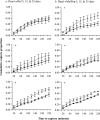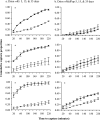Wolbachia infection alters olfactory-cued locomotion in Drosophila spp
- PMID: 18456851
- PMCID: PMC2446509
- DOI: 10.1128/AEM.02607-07
Wolbachia infection alters olfactory-cued locomotion in Drosophila spp
Abstract
Wolbachia pipientis is an endosymbiotic bacterium present in diverse insect species. Although it is well studied for its dramatic effects on host reproductive biology, little is known about its effects on other aspects of host biology, despite its presence in a wide array of host tissues. This study examined the effects of three Wolbachia strains on two different Drosophila species, using a laboratory performance assay for insect locomotion in response to olfactory cues. The results demonstrate that Wolbachia infection can have significant effects on host responsiveness that vary with respect to the Wolbachia strain-host species combination. The wRi strain, native to Drosophila simulans, increases the basal activity level of the host insect as well as its responsiveness to food cues. In contrast, the wMel strain and the virulent wMelPop strain, native to Drosophila melanogaster, cause slight decreases in responsiveness to food cues but do not alter basal activity levels in the host. Surprisingly, the virulent wMelPop strain has very little impact on host responsiveness in D. simulans. This novel strain-host relationship was artificially created previously by transinfection. These findings have implications for understanding the evolution and spread of Wolbachia infections in wild populations and for Wolbachia-based vector-borne disease control strategies currently being developed.
Figures




Similar articles
-
Male Age and Wolbachia Dynamics: Investigating How Fast and Why Bacterial Densities and Cytoplasmic Incompatibility Strengths Vary.mBio. 2021 Dec 21;12(6):e0299821. doi: 10.1128/mBio.02998-21. Epub 2021 Dec 14. mBio. 2021. PMID: 34903056 Free PMC article.
-
Wolbachia density and virulence attenuation after transfer into a novel host.Proc Natl Acad Sci U S A. 2002 Mar 5;99(5):2918-23. doi: 10.1073/pnas.052466499. Proc Natl Acad Sci U S A. 2002. PMID: 11880639 Free PMC article.
-
Mixed Wolbachia infections resolve rapidly during in vitro evolution.PLoS Pathog. 2024 Jul 25;20(7):e1012149. doi: 10.1371/journal.ppat.1012149. eCollection 2024 Jul. PLoS Pathog. 2024. PMID: 39052691 Free PMC article.
-
Wolbachia pipientis: intracellular infection and pathogenesis in Drosophila.Curr Opin Microbiol. 2004 Feb;7(1):67-70. doi: 10.1016/j.mib.2003.12.003. Curr Opin Microbiol. 2004. PMID: 15036143 Review.
-
Wolbachia infections in Drosophila melanogaster and D. simulans: polymorphism and levels of cytoplasmic incompatibility.Genetica. 2004 Mar;120(1-3):51-9. doi: 10.1023/b:gene.0000017629.31383.8f. Genetica. 2004. PMID: 15088646 Review.
Cited by
-
Bacterial supergroup-specific "cost" of Wolbachia infections in Nasonia vitripennis.Ecol Evol. 2022 Sep 13;12(9):e9219. doi: 10.1002/ece3.9219. eCollection 2022 Sep. Ecol Evol. 2022. PMID: 36172295 Free PMC article.
-
The native Wolbachia endosymbionts of Drosophila melanogaster and Culex quinquefasciatus increase host resistance to West Nile virus infection.PLoS One. 2010 Aug 5;5(8):e11977. doi: 10.1371/journal.pone.0011977. PLoS One. 2010. PMID: 20700535 Free PMC article.
-
Transinfected Wolbachia have minimal effects on male reproductive success in Aedes aegypti.Parasit Vectors. 2013 Feb 11;6:36. doi: 10.1186/1756-3305-6-36. Parasit Vectors. 2013. PMID: 23399027 Free PMC article.
-
Insect Behavioral Change and the Potential Contributions of Neuroinflammation-A Call for Future Research.Genes (Basel). 2021 Mar 24;12(4):465. doi: 10.3390/genes12040465. Genes (Basel). 2021. PMID: 33805190 Free PMC article. Review.
-
The effect of the endosymbiont Wolbachia on the behavior of insect hosts.Insect Sci. 2020 Oct;27(5):846-858. doi: 10.1111/1744-7917.12731. Epub 2019 Nov 11. Insect Sci. 2020. PMID: 31631529 Free PMC article. Review.
References
-
- Anderson, R. M., and R. M. May. 1982. Coevolution of hosts and parasites. Parasitology 85:411-426. - PubMed
-
- Brownstein, J. S., E. Hett, and S. L. O'Neill. 2003. The potential of virulent Wolbachia to modulate disease transmission by insects. J. Invertebr. Pathol. 84:24-29. - PubMed
-
- Clark, M. E., Z. Veneti, K. Bourtzis, and T. L. Karr. 2002. The distribution and proliferation of the intracellular bacteria Wolbachia during spermatogenesis in Drosophila. Mech. Dev. 111:3-15. - PubMed
-
- Clark, M. E., Z. Veneti, K. Bourtzis, and T. L. Karr. 2003. Wolbachia distribution and cytoplasmic incompatibility during sperm development: the cyst as the basic cellular unit of CI expression. Mech. Dev. 120:185-198. - PubMed
-
- de Crespigny, F. E., T. D. Pitt, and N. Wedell. 2006. Increased male mating rate in Drosophila is associated with Wolbachia infection. J. Evol. Biol. 19:1964-1972. - PubMed
Publication types
MeSH terms
LinkOut - more resources
Full Text Sources
Molecular Biology Databases
Miscellaneous

